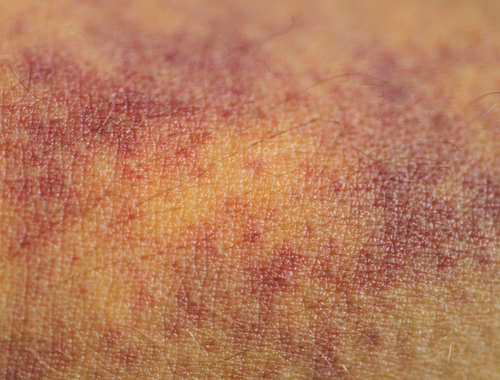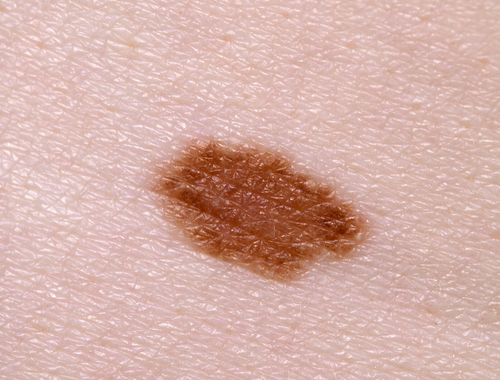Difference Between Hematoma and Melanoma
Both hematoma and melanoma involve the skin. Specifically, a hematoma occurs when trauma or injury causes blood to accumulate and pool under the skin. On the other hand, melanoma is a type of skin cancer that develops from pigment-producing cells called melanocytes. The following discussions further delve into their differences.

What is Hematoma?
“Hematoma” came from the Greek word “haima” which translates to “blood” and the Greek suffix “-oma” for “mass”. It is defined as a buildup of blood outside of blood vessels. It occurs when a trauma or injury causes blood to accumulate and pool under the skin.
Symptoms
The symptoms of hematoma include skin discoloration (red, blue, and purple), inflammation, tenderness, warmth, and pain. The accumulation of blood under the skin gives it a lumpy and rubbery feel.
Causes and Risks
The causes and risks of hematoma include the following (Nabili, 2022):
- Injury is the most common cause of hematoma; this includes medical procedures such as injections and biopsies.
- A hematoma may also occur without any apparent reason.
- Certain blood thinner medications (i.e., warfarin and aspirin) and supplements (i.e., garlic, vitamin E, and ginkgo biloba) may increase bleeding tendencies.
- People who have chronic liver disease, excessive alcohol use, bleeding disorders, or low platelet count are at a higher risk for hematomas.
Treatment
- Most small hematomas heal on their own. The treatments include applying ice, wrapping the affected area with a compression garment, pain killers, and avoiding anticoagulation medications.
- In some cases, a hematoma may need to be drained in order to remove the excess blood. This procedure is typically done in a hospital setting and may require local anesthesia.

What is Melanoma?
“Melanoma” came from the Greek word “melas” which means “black” or “dark” and “oma” which means “morbid growth” or “tumor”. Melanoma is a type of skin cancer that develops from pigment-producing cells called melanocytes.
Symptoms
The first sign is usually a new mole or an existing mole’s change in appearance. This is the ABCDE checklist (National Health Service, 2020):
Asymmetrical – Melanomas are often irregular in shape.
Border- Melanomas usually have ragged or notched borders.
Color- Melanomas often have a mix of at least two colors.
Diameter- Melanomas tend to be larger than 6 mm in diameter.
Enlargement or elevation- Melanomas’ sizes often change over time.
Causes and Risks
The causes and risks of melanoma include the following (Cancer Council):
- a history of tanning and sunburn
- a pattern of repeated brief, strong UV light exposure
- a lot of moles (more than 10 above the elbows and more than 50 on the body as a whole)
- increase of unusual moles
- family history of melanoma
- fair skin
- having freckles
- light eye color (i.e., blue or green)
- light or red hair color
- weak immune system
Treatment
- Surgery is usually used to treat early-stage melanomas.
- Other treatments include immunotherapy, chemotherapy, and radiation therapy.
- It is important to have any new or changing moles checked by a healthcare provider, as early detection and treatment of melanoma can greatly improve the chances of a successful outcome.
Difference between Hematoma and Melanoma
Etymology
“Hematoma” came from the Greek word “haima” which translates to “blood” and the Greek suffix “-oma” for “mass”. In comparison, “melanoma” came from the Greek word “melas” which means “black” or “dark” and “oma” which means “morbid growth” or “tumor”.
Definition
Hematoma is defined as a buildup of blood outside of blood vessels; it occurs when a trauma or injury causes blood to accumulate and pool under the skin. As for melanoma, it is a type of skin cancer that develops from pigment-producing cells called melanocytes.
Symptoms
The symptoms of hematoma include skin discoloration (red, blue, and purple), inflammation, tenderness, warmth, and pain. The accumulation of blood under the skin gives it a lumpy and rubbery feel. On the other hand, the first sign of a melanoma is usually a new mole or an existing mole’s change in appearance. Melanomas are often irregular in shape, have ragged or notched borders, have a mix of at least two colors, tend to be larger than 6 mm in diameter, and have sizes that often change over time.
Causes and Risks
Hematomas’ causes and risks include injury, blood thinner medications, chronic liver disease, excessive alcohol use, bleeding disorders, and low platelet count. Regarding melanoma, the causes and risks include history of tanning and sunburn, pattern of repeated brief, strong UV light exposure, a lot of moles (especially unusual ones), and family history of melanoma.
Treatment
Most small hematomas heal on their own.; the treatments include applying ice, wrapping the affected area with a compression garment, pain killers, avoiding anticoagulation medications, and draining to remove the excess blood. As for melanomas, surgery is usually used to treat the early stages; other treatments include immunotherapy, chemotherapy, and radiation therapy.
Hematoma vs Melanoma

Frequently Asked Questions (FAQs):
How do you rule out Subungual melanoma?
To rule out subungual melanoma, which presents as a brown-black discoloration of the nail bed, a dermatologist or healthcare provider will usually perform a physical examination of the affected area and may also take a biopsy of the tissue to examine it under a microscope.
Can melanoma look like a bruise?
Yes, a melanoma may look like a bruise, mole, sore, age-spot, cyst, dark spot, or a dark line beneath a nail.
Is it a bruise or melanoma toenail?
Signs of melanoma in a toenail may include a change in the shape or color of the nail, a dark streak under the nail, or a thickening or distortion of the nail. Unlike melanomas, bruises tend to heal after around two to four weeks. Biopsy may be required to rule out melanoma.
Is subungual hematoma cancerous?
No, subungual hematomas are not cancerous.
Can a hematoma be cancerous?
It is necessary to consider the possibility of a malignant soft tissue tumor if there is an unusual history of hematoma in the extremities (Valverde, 2016).
Does early melanoma bleed?
Bleeding usually occurs in more advanced melanoma.
Can melanoma be filled with blood?
A nodular melanoma can look like a blood blister which may bleed when poked or agitated; it may also bleed without agitation.
Do most melanomas bleed?
Melanomas can sometimes bleed, but it is not a common symptom.
Summary
- Hematoma is defined as a buildup of blood outside of blood vessels; it occurs when a trauma or injury causes blood to accumulate and pool under the skin.
- Melanoma, it is a type of skin cancer that develops from pigment-producing cells called melanocytes.
- The symptoms of hematoma include skin discoloration (red, blue, and purple), inflammation, tenderness, warmth, and pain.
- The first sign of a melanoma is usually a new mole or an existing mole’s change in appearance.
- Difference Between Hematoma and Melanoma - February 9, 2023
- Difference Between Bruising and Necrosis - February 8, 2023
- Difference Between Brain Hematoma and Brain Hemorrhage - February 8, 2023
Search DifferenceBetween.net :
Leave a Response
References :
[0]Cancer Council (n.d.) Melanoma. https://www.cancer.org.au/cancer-information/types-of-cancer/melanoma
[1]Nabili, S. (2022). Hematoma. RxList. https://www.rxlist.com/hematoma/drugs-condition.htm
[2]National Health Service. (2020). Skin cancer (melanoma). https://www.nhs.uk/conditions/melanoma-skin-cancer/symptoms/
[3]Valverde, J., Vinagreiro, M., Gouveia, P., Koch, P., Soares, V., & Gomes, T. (2016). Sarcoma the great masquerader hematoma deep vein thrombosis manifestation. International Journal of Surgery Case Reports. https://www.sciencedirect.com/science/article/pii/S2210261216304382#:~:text=When%20a%20patient%20presents%20with%20an%20unusual%20history%20of%20hematoma,a%20malignant%20soft%20tissue%20tumor.
